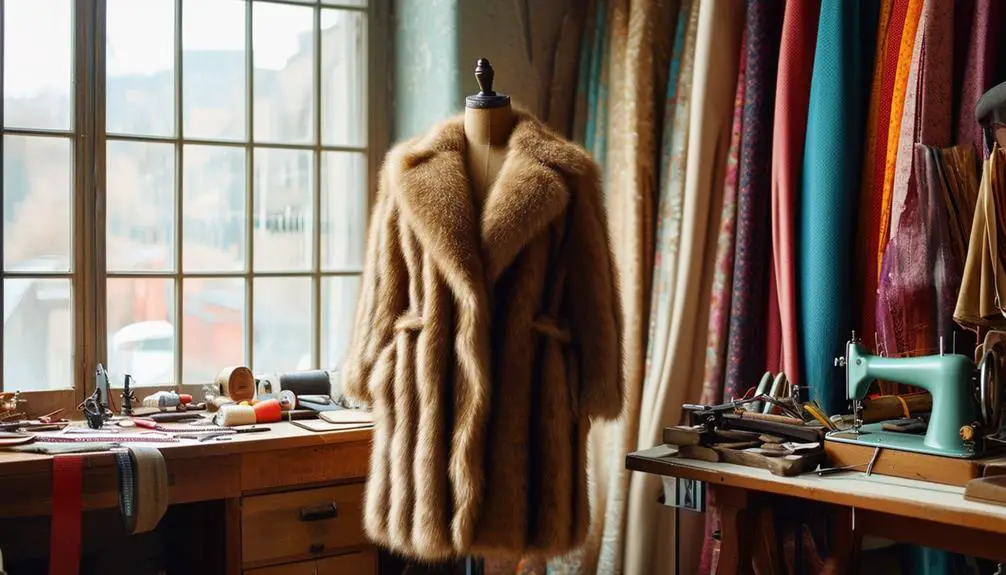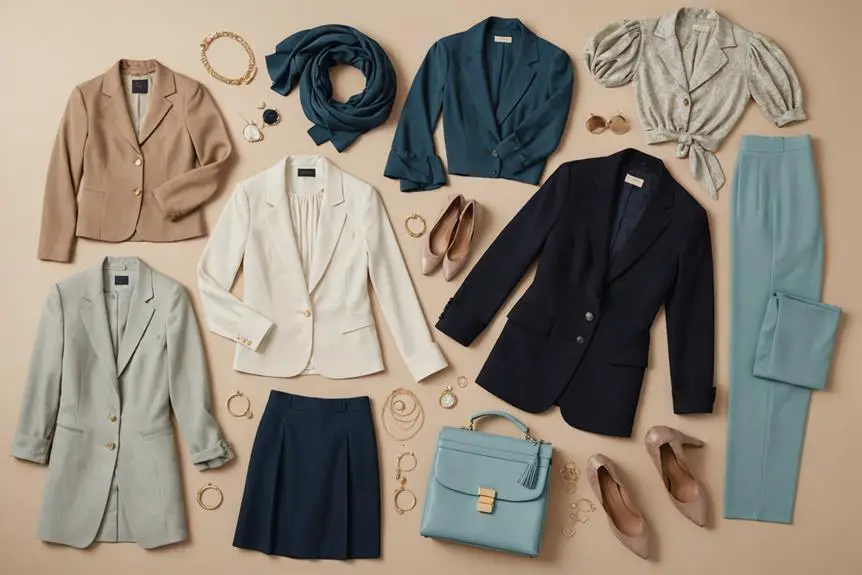To tailor a vintage fur coat, start by carefully evaluating its condition, checking for rips or wear in both the fur and lining. If shortening, remove the hem stitches and mark the new length with tailor's wax; cut carefully with a sharp mat knife. When reattaching, make certain the binding is secure and lining is modified for a seamless look. While DIY might seem tempting, professional alterations guarantee quality, especially for delicate vintage pieces, often starting at $300 and going higher for extensive changes. Knowledge about these processes can enhance your tailoring journey even further, offering you solutions to maintain your coat's integrity.
Assessing the Condition of Your Fur Coat
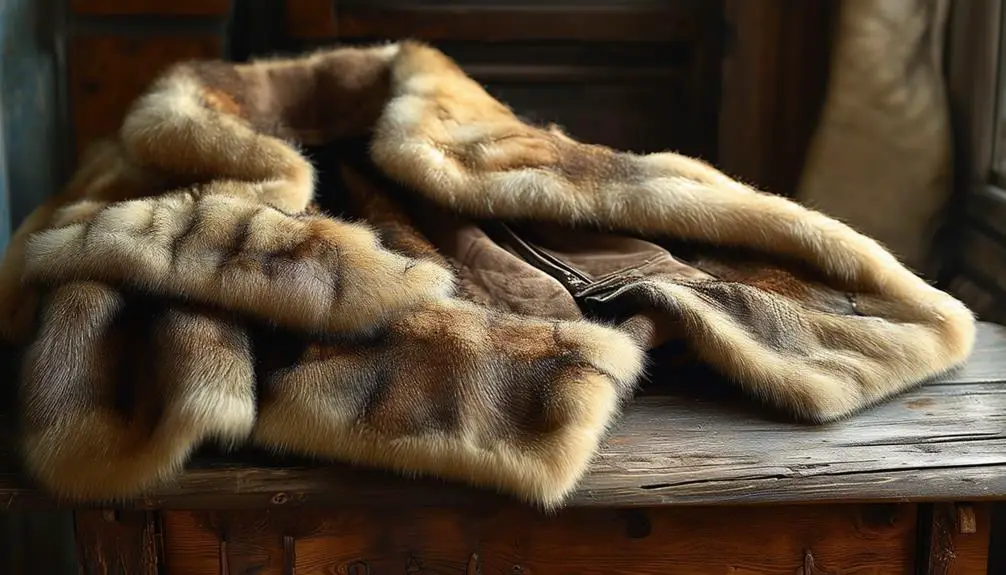
Evaluating the condition of your vintage fur coat is essential before diving into any alterations. Start by inspecting the fur coat for visible damage, looking for rips, tears, or worn patches, especially around high-friction areas like the sleeves and seams. These issues can compromise the coat's overall integrity and affect the alterations you may want to make.
Additionally, understanding the historical context of vintage fabrics can give you insight into the coat's construction and care requirements, which may influence your tailoring decisions vintage clothing characteristics.
Next, assess the condition of the pelts. Healthy fur should feel pliable; if it's stiff or crunchy, that's a sign of potential deterioration. This flexibility is vital for maintaining the coat's appearance and functionality.
Don't forget to examine the lining for any signs of wear or fraying, as these can impact the overall quality when adjustments are made.
Conduct a thorough visual inspection of the underside of the fur, noting any color fading or discoloration. These patterns might indicate sun damage or improper storage, which can greatly affect the fur coat's longevity.
Shortening Techniques for Fur Coats
When you decide to shorten your vintage fur coat, it's important to approach the task with care and precision to preserve its luxurious appearance.
Remember, the skin side is delicate, and any mistakes can mar the coat's beauty. Here are some key shortening techniques to follow:
- Remove hem stitches: Carefully detach the existing hem to expose the binding.
- Detach binding: Gently separate it from the fur, ensuring you don't damage the fur itself.
- Mark the new length: Use tailor's wax for precision when determining how much to shorten.
- Cut with care: Employ a sharp mat knife to make clean cuts on the fabric side, avoiding the fur.
- Reattach and adjust: Securely attach the binding and modify the lining to match the new length for a seamless finish.
Professional Vs. DIY Alterations
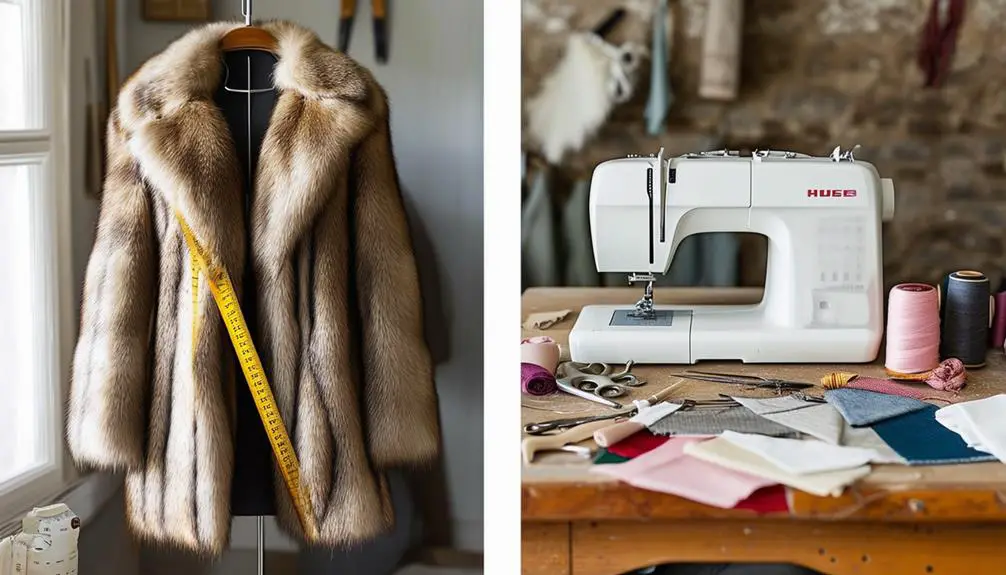
Choosing between professional and DIY alterations for your vintage fur coat can greatly impact both the coat's appearance and longevity.
While DIY alterations might seem like a budget-friendly option, they often come with risks. Without advanced sewing skills, you could easily damage the delicate fur or achieve unsatisfactory results. Furthermore, the intricacies of fur handling require specialized techniques that most DIY enthusiasts lack.
On the other hand, professional alterations guarantee quality results, though they typically start around $300. A skilled furrier not only understands how to resize or alter the coat without compromising its integrity but also preserves its value and aesthetic appeal. They possess the expertise needed for complex alterations that can make a significant difference in how your coat fits and looks.
While online resources can offer guidance for DIY projects, they're no substitute for hands-on experience. Precision and accuracy are critical when working with vintage fur, and one misstep can lead to irreversible mistakes.
As a result, if you're considering alterations, it's wise to consult a professional. This investment not only enhances your coat but also guarantees its longevity for years to come.
Repairing Damaged Fur
Damage to a vintage fur coat can be disheartening, but addressing it promptly can restore its beauty and functionality. Here's a concise guide to repairing damaged fur effectively:
- Inspect the coat thoroughly, focusing on sleeves and seams for any rips or tears.
- Use furrier tape on the skin side of the rip for a secure mend, avoiding regular adhesives that can harm the pelts.
- Choose the right needle: a glover or leather hand needle minimizes risks of further damage compared to standard needles.
- Monitor your coat's condition post-repair. Check for stiffness or cracking, as these signs indicate a need for ongoing maintenance.
- Consult a professional furrier for significant repairs, ensuring the coat's integrity is preserved and avoiding costly mistakes.
Cost Considerations for Alterations
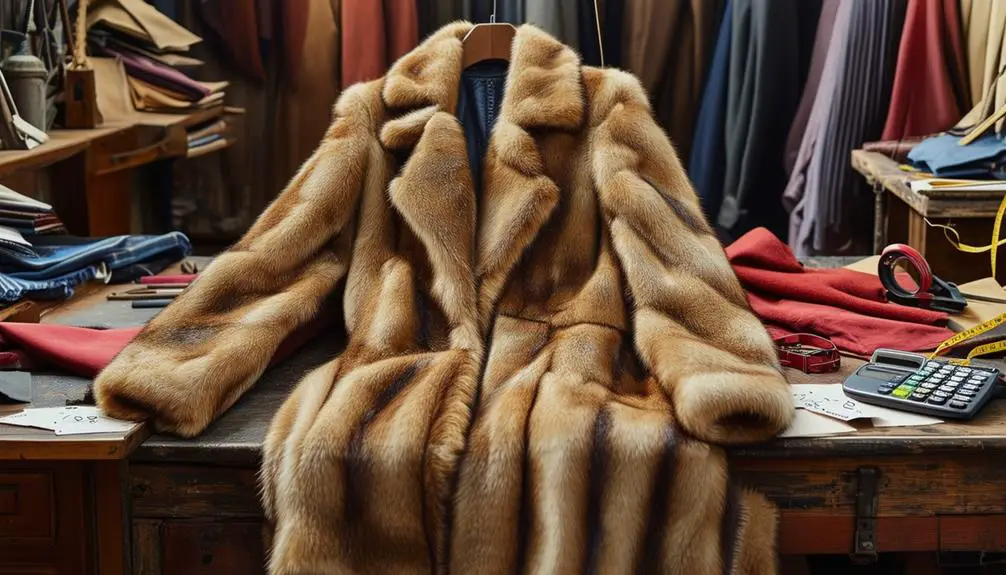
Maneuvering the costs associated with alterations for a vintage fur coat requires careful consideration of various factors. The average cost for professional shortening of a fur coat starts around $300, reflecting the specialized techniques necessary for such delicate materials.
However, vintage fur coats often incur higher alteration costs due to their intricate construction, with some services ranging from $1500 to $2000 for more extensive tailoring.
When budgeting for these alterations, keep in mind that professional furriers charge for both labor and materials. If your coat needs significant resizing or if the fur is in poor condition, costs can escalate further.
Additional repairs might be necessary before any alterations can even begin, adding to your financial considerations.
To navigate these potential expenses effectively, it's wise to consult with a furrier upfront. Doing so can provide a clearer estimate of the total costs involved, allowing you to make informed decisions about the feasibility of the alterations you desire.
Styling Your Tailored Fur Coat
How can you effortlessly elevate your wardrobe with a tailored vintage fur coat? These exquisite pieces not only provide warmth but also versatility, seamlessly shifting from casual to formal settings.
Here are some styling tips to make the most of your tailored vintage fur coat:
- Pair with jeans for a chic, laid-back look.
- Dress it up with an elegant dress for a sophisticated evening.
- Accessorize with scarves, hats, or statement jewelry to personalize your outfit.
- Cinch your waist with a belt to enhance the flattering A-line silhouette.
- Experiment with layering options, like a fitted blazer or a chunky sweater, to add depth and interest.
Shortened vintage fur coats offer a trendy aesthetic while maintaining comfort, making them ideal for receptions or operas.
By skillfully accessorizing and layering, you can create eye-catching combinations that reflect your unique style.
Remember, the key is to mix and match elements that resonate with you, allowing your tailored vintage fur coat to shine as the centerpiece of your outfit.
Embrace the elegance and warmth of your fur coat, and enjoy the endless styling possibilities it brings!
Frequently Asked Questions
Can Fur Coats Be Tailored?
Yes, fur coats can be tailored, but it's complex. You should consult a professional furrier who understands the unique materials and construction. They'll guarantee alterations enhance fit without damaging the coat's integrity.
What Do I Do With Vintage Fur Coats?
You can cherish vintage fur coats by wearing them, displaying them, or restoring their beauty. Consider their sentimental value, consult experts for care, and join communities for tips on maintenance and preservation.
How Do You Update an Old Fur Coat?
To update an old fur coat, consider shortening its length, replacing linings, or adding embellishments. Consulting a specialized fur tailor guarantees your choices enhance its aesthetic while respecting its historical value and integrity.
Are Old Furs Worth Anything?
Old furs can be worth quite a bit, depending on their type, condition, and age. High-quality pieces, like mink or sable, usually retain value, but market trends are shifting towards sustainable fashion, affecting resale potential.
